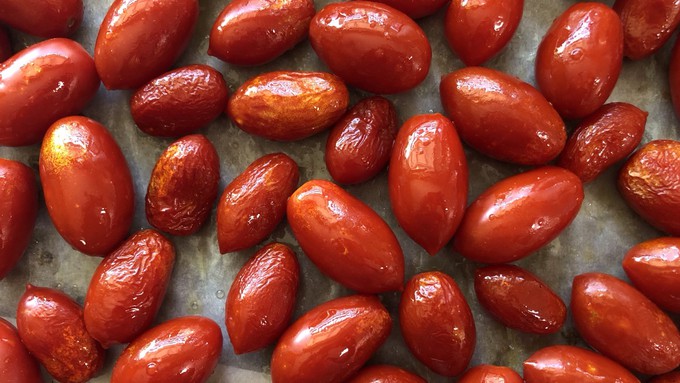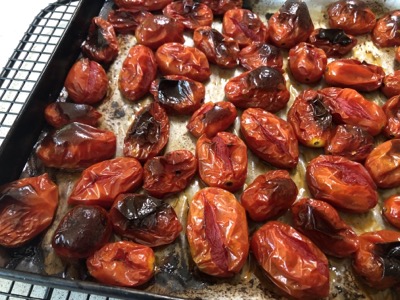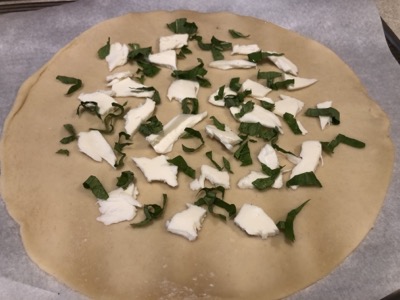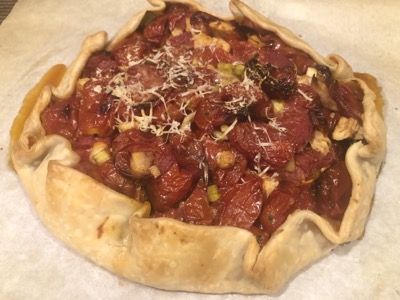
Recipe: Flexible recipe uses cheese, pre-made crust

They're late in the season but still delicious: Juliet tomatoes, ready for roasting. Kathy Morrison
The tomato plants are disappearing from the community garden I belong to. One here, one there, then whole plots of them -- their luscious fruits now canned or frozen or just memory. It's nearly fall, and many gardeners are done with summer.

Of course the heat wave killed off many summer vegetable plants, and in others it halted the will to reproduce. Still, some of us stubbornly keep our plants in place. How could I tear out something that looks so healthy? For now, the Juliet tomato plant survives, along with a few others, and I get to enjoy her meaty tomatoes that are even more precious now that they are dwindling.
The recipe here is an excellent way to use any late-summer veggies. And thank goodness the weather has cooled down, because roasting the veggies first is a must, to concentrate the flavors and let the excess liquid cook off.
Use what you have: zucchini, peppers, eggplant, scallions, garlic -- and of course tomatoes. The cheese and herbs are also flexible: Goat cheese or Gruyere instead of mozzarella, for example, and thyme or oregano instead of basil. I included a cup of cubed rotisserie chicken, because I had it, but that is optional.
Roasted summer vegetable galette
Serves 4-6
Ingredients:
4 to 6 cups summer vegetables, such as tomatoes, zucchini or peppers, halved or cut into 1-inch pieces
Olive oil
1 premade refrigerated pastry crust, allowed to sit out at room temperature for a few minutes
1 cup cubed cooked chicken or ham (optional)
3 or 4 scallions, trimmed and sliced
4 ounces fresh mozzarella or other soft or semi-soft cheese, such as goat cheese or grated Gruyere
2 to 3 tablespoons chopped fresh herbs, such as basil or parsley, or 1 teaspoon dried herbs
Salt
Freshly grated black pepper
Grated Parmesan cheese
Water or cream for brushing crust, optional
Instructions:

Preheat oven to 425 degrees. Spread the tomatoes and/or other veggies on a quarter-sheet baking pan. Drizzle olive oil over it, and stir, making sure all the veggies get a little. Roast for 20-30 minutes or until vegetables are tender. Some brown is fine.
Remove from oven and allow to cool. Some of the veggies may give off a lot of liquid. Pour that off and discard or use it to make vegetable broth.
When the veggies are mostly cool, scrape them into a large measuring cup. You should have at least 3 cups of roasted vegetables. (You may need to pour out more liquid here.)
Reduce the oven temperature to 375 degrees. Unroll the premade pastry onto a baking sheet covered with parchment paper. If the pastry is getting too soft to work with, pop the pan into the freezer for a few minutes. In a large bowl, combine the veggies, the scallions, the chicken or ham (if using), and salt and pepper to taste.
Distribute the basil and dabs of fresh mozzarella (or whatever you're using) over the pastry round, leaving about 1-1/2 inches open around the edge. Mound the galette filling over the herbs and cheese.
Fold the pastry edge up, pleating it as you go. This is a rustic tart, so don't worry about perfection.

Sprinkle some Parmesan over the filling. If desired, brush the crust edges with water or cream.
Bake 25 minutes or until the crust is golden and the filling is bubbling.
Allow to cool at least 10 minutes before serving. Serve warm or at room temperature.
Comments
0 comments have been posted.Sacramento Digs Gardening to your inbox.
Sites We Like
Garden Checklist for week of April 14
It's still not warm enough to transplant tomatoes directly in the ground, but we’re getting there.
* April is the last chance to plant citrus trees such as dwarf orange, lemon and kumquat. These trees also look good in landscaping and provide fresh fruit in winter.
* Smell orange blossoms? Feed citrus trees with a low dose of balanced fertilizer (such as 10-10-10) during bloom to help set fruit. Keep an eye out for ants.
* Apply slow-release fertilizer to the lawn.
* Thoroughly clean debris from the bottom of outdoor ponds or fountains.
* Spring brings a flush of rapid growth, and that means your garden needs nutrients. Fertilize shrubs and trees with a slow-release fertilizer. Or mulch with a 1-inch layer of compost.
* Azaleas and camellias looking a little yellow? If leaves are turning yellow between the veins, give them a boost with chelated iron.
* Trim dead flowers but not leaves from spring-flowering bulbs such as daffodils and tulips. Those leaves gather energy to create next year's flowers. Also, give the bulbs a fertilizer boost after bloom.
* Pinch chrysanthemums back to 12 inches for fall flowers. Cut old stems to the ground.
* Mulch around plants to conserve moisture and control weeds.
* From seed, plant beans, beets, cantaloupes, carrots, corn, cucumbers, melons, radishes and squash.
* Plant onion sets.
* In the flower garden, plant seeds for asters, cosmos, celosia, marigolds, salvia, sunflowers and zinnias.
* Transplant petunias, zinnias, geraniums and other summer bloomers.
* Plant perennials and dahlia tubers for summer bloom.
* Mid to late April is about the last chance to plant summer bulbs, such as gladiolus and tuberous begonias.
* Transplant lettuce seedlings. Choose varieties that mature quickly such as loose leaf.